Читать книгу Human Metabolism - Keith N. Frayn - Страница 49
1.3.4.3 Metabolism of the carbon skeleton
ОглавлениеFollowing deamination, the remaining carbon skeleton enters the common metabolic pool; its fate depends on where it enters this pool of intermediary metabolites. All amino acid carbon skeletons ultimately yield just seven products of intermediary metabolism: pyruvate, 2-oxoglutarate (α-ketoglutarate), succinyl-CoA, fumarate, oxaloacetate, acetyl-CoA and acetoacetyl-CoA. The first five of these represent ≥ 3 carbons, hence amino acids producing these metabolites can be used for glucose synthesis (‘glucogenic’): it is this property that confers on proteins the ability to act as a carbohydrate reserve. The acetyl-CoA and acetoacetyl-CoA, however, yield two (or the equivalent to two) carbons, and amino acids which produce them cannot be used for gluconeogenesis (since PDH cannot be reversed (see Section 1.3.1.3 above) – they can only be oxidised directly in the TCA cycle, undergo lipogenesis or be used to synthesise ketone bodies (‘ketogenic’). This is illustrated in Figure 1.23).
Figure 1.23 Metabolism of the carbon skeletons of amino acids following their deamination. Following deamination, the remaining 2-oxoacid (carbon skeleton) enters intermediary metabolism in one of only seven sites. Glucogenic amino acids are shown in blue, ketogenic amino acids in green.
